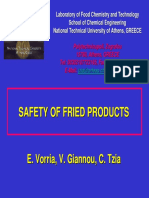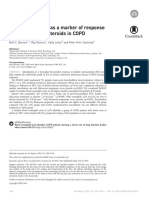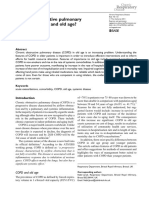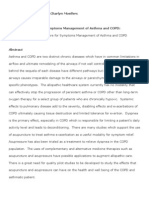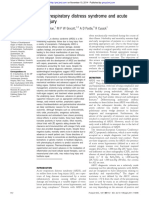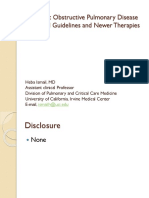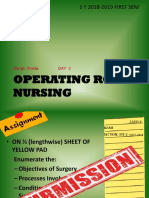Effect On Oral NAC in COPD
Effect On Oral NAC in COPD
Uploaded by
Meiyanti MeiyantiCopyright:
Available Formats
Effect On Oral NAC in COPD
Effect On Oral NAC in COPD
Uploaded by
Meiyanti MeiyantiOriginal Title
Copyright
Available Formats
Share this document
Did you find this document useful?
Is this content inappropriate?
Copyright:
Available Formats
Effect On Oral NAC in COPD
Effect On Oral NAC in COPD
Uploaded by
Meiyanti MeiyantiCopyright:
Available Formats
original article
Effect Of Oral N-Acetylcysteine In COPD- A Randomised
Controlled Trial
Arshad Altaf Bachh, Naveed Nazir Shah, Rakesh Bhargava, Zuber Ahmed, D.K. Pandey, Khurshid A Dar,
Inaamul Haq
Abstract
To study the effect of addition of N- acetylcysteine to the standard treatment on clinical & physiological
parameters and frequency of exacerbations in patients of chronic obstructive pulmonary disease (COPD).
A total of 100 adult patients diagnosed as having moderate to severe COPD (GOLD guidelines) attending
OPD/IPD of Department of Tuberculosis & Chest diseases, JNMCH, AMU, Aligarh were included in a single
blind, randomized, placebo controlled trial. The patients were randomly distributed into a study group (n=50)
who were given oral N acetylcysteine 600mg daily in addition to the standard treatment and a control group
(n=50) who were put on standard treatment alone. Both the groups were followed up for a period of 1 year.
History, clinical examination and PFTs were performed at the start of the trial. The occurrence of
exacerbations was studied at the end of 1 year with PFTs being done at 2 monthly intervals.
In 50% of patients of NAC group there were at least 1 exacerbation more compared to 76% in the control
group, hence a reduction of exacerbations by 26%(p<0.05). Also the number of patients with 2 or more
exacerbations was lower in the study group (30%) than in the control group (36%) (p >0.05). The number of
hospital admission during the study period was significantly lower in the study group (37) than in the control
group (55). There was a significant improvement in spirometric parameters (FEV1 & FEF 25-75) in the study
group. There were no adverse effects related to NAC in the study group. Statistical analysis was done using
z test and Chi square test.
The addition of N-acetylcysteine resulted in a significant reduction in the number of exacerbations and
hospital admissions in the patients of moderate to severe COPD along with an improvement in lung function
parameters.
JK-Practitioner 2007;14(1):12-16
INTRODUCTION:
Chronic Obstructive Pulmonary Disease (COPD) is the most
common respiratory illness in the elderly and is ranked as 3rd and 4th most
1,2
common cause of death in Europe and USA respectively . COPD is
characterized by chronic airflow limitation, that is not fully reversible,
usually progressive and airflow obstruction associated with inflammation of
Authors’ affiliations: the airways1. Acute episode of increase in severity of the disease with
A A Bachh, N N Shah, R Bhargava, irreversible airway obstruction is known as an exacerbation. The frequency
3,4
Zuber Ahmad, D K Pandey, K A Dar of these exacerbations varying between 1.3-4 per year . Oxidative stress
5,6
Department of Tuberculosis and has been implicated in the pathogenesis and progression of COPD . Both
Chest Diseases reactive oxygen species from inhaled cigarette smoke and those formed
Inaamul Haq endogenously by inflammatory cells are responsible for increased
Department of Community intrapulmonary oxidant burden. These oxidants contribute to irreversible
Medicine damage to the lung parenchyma and airway wall and alterations in the local
7
immune response . This may in turn lead to increased risk of infections and
Jawaharlal Nehru Medical College exacerbations leading to a rapid decline in lung functions.
AMU, Aligarh UP (India) The inflammation in stable COPD patients is dominated by
macrophages, CD8+ T lymphocytes and neutrophils in bronchial submucosa
Accepted for Publication 6
and alveoli . Chemical mediators like Interleukin (IL)-8, Tumour necrosis
May 2006 factor á (TNF-á), and Leucotriene B4 (LT B4) attract inflammatory cells and
increase oxidant production from these cells. Attenuation of oxidative stress
Corresponding Author: would be expected to result in reduced pulmonary damage and decrease in
Dr. Arshad Altaf Bachh local infections, thus reducing the progression of COPD. At present the only
Department of Tuberculosis & Chest treatment that has been shown to slow COPD progression is smoking
Diseases JNMCH, AMU, Aligarh UP 9
cessation . Inhaled corticosteroids cause a small improvement in forced
India
expiratory volume in 1st second (FEV1), but in general, don't affect the
Email: naveednazirshah@yahoo.com
decline in FEV1 thought to be the most direct measure of the progression of
8
COPD . N-acetyl cysteine (NAC), a mucolytic with antioxidant and anti-
10,11
inflammatory properties is prescribed in COPD in a belief to reduce
exacerbation and improve symptoms.
A number of studies conducted on a large series of patients
provided evidence for a reduction in symptoms, duration and rate of
Keywords : COPD, N- acetylcysteine, FEV1, FEF , Exacerbation
25-75
12 JK- Practitioner Vol.14, No. 1, January-March 2007
original article
12,13 14
exacerbations and in the number of sick days . However, monthly intervals. The number of exacerbations at the end
15
this has not been found in all the studies . The objective of of the year for each patient in both the groups was recorded.
present study was to evaluate the effect of NAC on the An exacerbation was defined as "increased dyspnea and/or
frequency of exacerbations of COPD and on the cough associated with a change in quality and quantity of
physiological parameters. sputum, which led the patient to seek medical attention and
MATERIAL AND METHODS lasting for ³ 3 days". The exacerbations were managed
A single blind, randomized, placebo controlled with appropriate care as judged by the physician. The total
study, approved by the hospital ethics committee, was numbers of hospital admissions were recorded in both the
carried out on patients attending OPD/IPD Department of groups. Hospital admissions were made on the basis of
Tuberculosis and Chest Diseases, JNMC, AMU, Aligarh severity of exacerbation and in accordance with hospital
between March 2004 and November 2005. protocol.
Inclusion Criteria: Patients fulfilling the following criteria Statistical analysis: Statistical analysis was done by Chi-
were included: Square test and z- test. p<0.05 was taken as stastically
(1) Smoking related COPD (2) Age > 50 years (3) significant.
any race or sex (4) Smokers and ex-smokers (4) History of OBSERVATIONS AND RESULTS
2 exacerbations per year during 2 years prior to the start of The mean age of the patients in the study group
the study. (5) FEV1 reversibility < 12% of the predicted was 62.6 (± 6.2) years and 60.1 (± 7.3) years in the control
value, 15 min after 400 g of inhaled salbutamol. (6) FEV1/ group. There were 38 males (76%) in the study group and
Forced vital capacity (FVC) < 70% and post bronchodilator 40(80%) in the control group. The mean smoking history in
FEV1 30 to 80% predicted. (7) Not allowing any the study group was 42.1(±7.1) pack years and 46.1(±8.2)
medication except those prescribed, inhaled corticosteroids pack years in the control group. The mean duration of
(ICS) were allowed at a fixed dose throughout the study disease was 6 (±4) years in the study group and 6.8(±2)
period. years in the control group. The mean number of
Exclusion Criteria: Patients with the following exacerbations in 2 years preceding the enrollment of the
characteristics were excluded: patients in the study and control group was 4.6 (±1.6) and
(1) History of asthma, allergic rhinitis or any other 4.8 (±1.2) respectively. The mean post bronchodilator
concomitant respiratory illness. (2) Known history of FEV1 % predicted in patients in the study and control group
intolerance to NAC. (3) Patients who had taken NAC for >3 was 52.1 (±10.1) % and 51.3 (±9.6) % respectively. The
months previously. (4) Congestive heart failure Class > 2, mean FEV1 reversibility in patients in study and control
New York Heart Association. (NYHA) (5) Non-compliance group was 6.6 (±3.2)% and 5.9 (±2.3)% [Table 1]. There
in taking medication (6) Continuous treatment with oral was no significant difference in the baseline characteristics
corticosteroids between the study and control group (p>0.05).
A total of 100 patients diagnosed as having The concurrent medications in the study and
1
moderate to severe COPD {GOLD guidelines }were control group were in the following order: Theophylline
included in the trial. At the first visit of the patient, a {37(76%) in study group and 32(64%) in the control
detailed clinical history, physical examination, pulmonary group}, inhaled short acting ß2 agonist {24 (48%) in study
f u n c t i o n s t e s t s ( P F Ts ) , c h e s t r a d i o g r a p h , group and 20(40%) in the control group}, inhaled
electrocardiography and other relevant laboratory tests anticholinergic {30(60%) in the study group and 25(50%)
were recorded. Special attention was given to the method of in the control group}, inhaled long acting ß2 agonist
spirometry. Which was done in accordance with European {18(36%) in study group and 20(40%) in the control
16
Respiratory Society (ERS) standards . group}, and inhaled corticosteroids {10(20%) in study
Spirometry was done at the same time of the day, group and 8(16%) in the control group}[Table 2].
with the subject in seated position & wearing a nose clip. The number of patients who had exacerbations in
The best of ³ 3 technically satisfactory attempts was the study group was lower than those in the control group in
chosen. At each visit FEV1, FVC and FEF 25-75
were the 1-year follow up period. Only 25(50%) patients in the
measured. All measurements were performed before and 15 study group had atleast 1 exacerbation as compared to
minutes after administration of 400 micrograms of inhaled 38(76%) in the control group i.e. a reduction of
salbutamol. Spirometry was postponed for 6 weeks if an 26%(p<0.01, statistically significant). 15(30%) of the
exacerbation was present. patients in the study group had 2 or more exacerbations
If complying with the inclusion criteria, an during the follow-up period as compared to 18(36%) in the
informed consent was taken and the patients were control group i.e. a reduction of 6%(p>0.05, statistically
randomized into two equal groups (n=50). Patients were insignificant)[Table 3]. The total number of hospital
advised to quit smoking prior to the trial. Study group was admissions was lower in the study group (37) as compared
administered NAC 600mg once daily at the same time of the to the control group (55)(p<0.05) [Table 4]. The
day for a period of 4 months. Control group was given improvement in physiological parameters of lung function
placebo tablets. Standard treatment for COPD was was significantly greater in the study group (FEV1 by
prescribed to both groups according to severity and in 4.6±1.8%; FEF25-75 by 3.1±1.2%) as compared to control
accordance with GOLD guidelines. Patients were followed group (FEV1 by 3.9±1.6%; FEF25-75 by
up for a period of one year. 2.6±1.0%)(p<0.05) [Table 4]. There were no major side
At each follow up visit a detailed history was taken effects or complications attributed to NAC in the study
and clinical evaluation was done. PFTs were done at 2 group.
JK- Practitioner Vol.14, No. 1, January-March 2007 13
original article
Table 1 : Patient Characteristics
Variable Study group n=50 Control group n=50
1. Age, years 62. 6+ 6.2 60.1 + 7.3
2. Gender M/F 38 / 12 40 / 10
3. Smoking history, Pack years 42.1 + 7.1 46.1 + 8.2
4. Duration of disease, years 6+4 6.8 + 2
5. No. of exacerbations in last 2 years 4.6 + 1.6 4.8 + 1.2
6. Post bronchodilator REV1 (% predicted) 52.1 + 10.1 51.3 + 9.6
7. FEV1 reversibility (%) 6.6 + 3.2 5.9 + 2.3
Table 2 : Concurrent Medications
Variable Study group n=50 Control group n=50
1. Theophylline 37 (76) 32 (64)
2. Inhaled short acting B2 agonist 24 (48) 20 (40)
3. Inhaled anti-cholinergic 30 (60) 25 (50)
4. Inhaled long acting B2 agonist 18 (36) 20 (40)
5. Inhaled corticosteroid 10 (20) 8 (16)
Table 3 : Exacerbation rate in the two groups Table 4 : Hospital admissions in the two groups
No. of patients (%) No. of hospital admissions
At least 1 >2
Exacerbation Exacerbation Study group 37
Study group 25 (50) 15 (30) Control group 55
Control group 38 (76) 18 (36) P value P< 0.05
P value P < 0.01 P> 0.50
Statistical analysis was done by Chi-Square test
Statistical analysis was done by Chi-Square test
Table 5 : Physiological parameters in the two groups
Post bronchodilator Post bronchodilator
FEV1 % predicted FEF % predicted
25-75
Study group Control group Study group Control group
Start of trail 52.1 + 10.1 51.3 + 9.6 24.6 + 2.3 23.2 + 1.9
End of trail 56.9 + 11.4 55.2 + 7.8 27.7 + 2.1 25.8 + 1.8
Change 4.6 + 1.8 3.9 + 1.6 3.1 + 1.2 2.6 + 1.0
p value < 0.05 < 0.05
Statistical analysis was done by z-text
14 JK- Practitioner Vol.14, No. 1, January-March 2007
original article
DISCUSSION resulted in significant reduction in number of exacerbation.
NAC, a thio-containing compound, acts as a Similar results were obtained in our study where the
mucolytic, antioxidant and has some anti-inflammatory exacerbation rate was reduced by 26% in the NAC group.
properties. Mucolytic properties of NAC are attributed to The decrease in the frequency of exacerbations by using
the free sulphydryl (-SH) groups it contains, which split the NAC also reduces the need for hospital admission. Gerrits
3
disulphide linkages of mucoproteins in the viscous mucus et al. observed that NAC reduces the risk of
3
reducing its viscosity and making it less tenacious . Vestbo rehospitalization for COPD by ~30% which is similar to
17
et al. showed that chronic mucus hyper secretion is 32.7% in our study. However, addition of NAC to the
significantly associated with an increased risk of treatment with corticosteroids and bronchodilators does not
24
hospitalization of COPD patients. This combined with loss modify the outcome in acute exacerbations of COPD .
of mucociliary clearance, leads to mucus pooling that Clinicians and patients will need to judge for themselves
stimulates bacterial colonization, although the precise role whether the reduction in exacerbation rate seen with
18
of bacteria in COPD exacerbations is debatable . NAC mucolytic drugs are large enough to warrant their daily
directly prevents bacterial adherence to epithelial cells and administration for a period of 3-6 months each year. A
is associated with low mucus bacterial counts .
19
recent analysis of cost effectiveness of NAC in chronic
NAC exhibits both direct as well as indirect antioxidant bronchitis suggest that the point at which cost of treatment
properties. Direct effect being due to free thiol group, which and non-treatment are equal was 0.6 fewer exacerbations
23
interacts with electrophillic group of reactive oxygen per six months .
20
species (ROS) . Indirect antioxidant effect is related to its It is debatable whether NAC should be administered
role as glutathione (GSH) precursor, which serves as a prophylactically to reduce the number of exacerbation or
central factor in protecting against both internal and the exacerbation itself should be treated, on cost effective
external toxic agents . 20
basis. At recommended doses, the available mucolytics cost
Our study shows that the use of the mucolytic agent, NAC, around Rs 6000(US$120) while a short course of antibiotics
in patients >50 years reduces the frequency of and oral steroids for one infective exacerbation cost around
exacerbations, rehospitalization for exacerbations within 1 Rs. 200 (US$4). Studies are going on to check the cost
year of previous hospitalization and leads to an effectiveness of the drug as prophylaxis for reducing the
25
improvement in pulmonary physiological parameters exacerbations of COPD .
[FEV1, FEF ). There was an improvement in FEV1 by
25-75
The reduction in the exacerbation rate per month was
4.6% and FEF by 3.9% which is statistically significant.
25-75
greater for the studies that lasted three months or less (0.13
21
Studies conducted by Aylward et al. and a Multicentric per subject) than for those that lasted over three months
13
Study Group showed similar improvements in FEV1 of (0.06 per subject). This suggests that the full benefit is seen
23
5% and 4% respectively. However some trials have shown early and does not increase subsequently .
no effect of NAC on FEV1 .
12 CONCLUSION
A recent meta-analysis by Grandjean et al showed an 22 Regular use of mucolytic drugs for at least 4 months in
overall 23% reduction in exacerbation frequency, although patients with COPD significantly reduces exacerbations
some inhomogeneity of the effect appeared to be present. and leads to a significant improvement in the physiological
The duration of the treatment in these trials, however, was parameters compared with placebo.
limited to 6 months. Similar results were obtained by Stey et Future randomized controlled trials should review the value
11 of mucolytic drugs in treatment of patients with acute
al. in a meta-analysis of 11 previous studies on NAC with
exacerbations of COPD and determine the cost
treatment periods of 12 to 24 weeks. In a systematic review
23 effectiveness of the drug.
Poole and Black found that regular use of mucolytus
References
1. Pauwels RA, Buist AS, Calverley 98. Foundations. New York, NY, Raven
PMA, Jenkins CR, Hurd SS. Global 4. Dewan NA, Rafique S, Kanwar B, Press Ltd., 1997; pp 2279-88.
strategy for the diagnosis, Satpathy H, Ryschon K, Tillotson 8. Burge PS, Calverley PMA, Jones
management, and prevention of GS, et al. Acute exacerbation of PW, Spencer P, Anderson JA, Maslen
chronic obstructive pulmonary COPD: factors associated with poor TK. Randomized, double blind,
disease. Am J Respir Crit Care Med treatment outcome. Chest 2000; 117: placebo controlled study of
2001; 163: 1256-76. 662-71. fluticasone propionate in patients
2. Jeffery PK. Structural and 5. MacNee W. Oxidants/antioxidants with moderate to severe chronic
inflammatory changes in COPD: a and COPD. Chest 2000; 117: 5 obstructive pulmonary disease: the
comparison with asthma. Thorax Suppl. 1: 303S-17S. ISOLDE trial. BMJ 2000; 320: 1297-
1988; 53: 129-36. 6. Barnes PJ. Chronic obstructive 303.
3. Gerrits CMJM, Herings RMC, pulmonary disease. N Engl J Med 9. Anthonisen NR, Connect JE, Kiley
Leufkens HGM, Lammers JWJ. N- 2000; 343: 269-80. JP, Altose MD, Bailey WC, Buist AS,
acetylcysteine reduces the risk of re- 7. Warren JS, Johnson KJ, Ward PA. et al. Effects of smoking intervention
hospitalization among patients with Consequences of oxidant injury. In: and the use of anticholinergic
chronic obstructive pulmonary Crystal RG, West JB, Weibel ER, bronchodilator on the rate of decline
disease Eur Respir J 2003; 21: 705- Barnes PJ, eds. The Lung: Scientific of FEV1. The lung health study.
JK- Practitioner Vol.14, No. 1, January-March 2007 15
original article
JAMA1994; 272: 1497-505. N-acetylcysteine and exacerbation in the treatment of patients with
10. Tunek A. Possible mechanisms rates in patients with chronic chronic obstructive bronchitis: a
behind the anti-inflammatory effects bronchitis and severe airways balanced double-blind trial with
of N-acetylcysteine: is metabolism obstruction. Thorax 1985; 40: 823- placebo control. Eur J Respir Dis
essential? Eur Respir Rev 1992; 2: 7, 35. 1980; 61 Suppl. 111: 81-9.
35-8. 16. Quanjer Ph. Standardized lung 22. Grandjean EM, Berthet P, Ruffman
11. Stey C, Steurer J, Bachmann S, function testing Eur Respir J 1993; 6 R, Leuenberger P. Efficacy of oral
Medici TC, Tramer MR. The effects Suppl 16: 5-40. long-term N-acetylcysteine in
of oral N-acetylcysteine in chronic 17. Vestbo J, Prescott E, Lange P. chronic bronchopulmonary disease:
bronchitis: a quantitative systematic Association of chronic mucus a meta-analysis of published double-
review. Eur Respir J 2000; 16: 253- hypersecretion with FEV1 decline blind, placebo-controlled clinical
62. and chronic obstructive pulmonary trials. Clin Ther 2000; 22: 209-21.
12. Boman G, Backer U, Larsson S, disease morbidity. Copenhagen City 23. Poole PJ, Black PN. Oral mucolytic
Melander B, Wahlander L. Oral Heart Study Group. Am J Respir Crit drugs for exacerbations of chronic
acetylcysteine reduces exacerbation Care Med 1996; 153: 1530-5. obstructive pulmonary disease:
rate in chronic bronchitis: report of a 18. Hirshman JV. Do bacteria cause systematic review. BMJ 2001; 322:
trial organized by the Swedish exacerbations of COPD? Chest 2000; 1-6.
Society for Pulmonary diseases. Eur 118: 193-193. 24. Black PN, Morgan-Day A, McMillan
J Respir Dis 1983; 64: 405-15. 19. Riise GC, Qvarfordt I, Larsson S, T E , P o o l e P J , Yo u n g R P.
13. Multicentre Study Group. Long-term E l i a s s o n V, A n d e r s s o n B A . Randomized, control trial of N-
oral acetyl-cysteine in chronic Inhibitory effect of N-acetylcysteine acetylcysteine for treatment of acute
bronchitis. A double blind controlled on adherence of Streptococcus exacerbations of chronic obstructive
study. Eur J Respir Dis 1980; 61 pneumoniae and Haemophilus pulmonary disease. BMC Pulm Med
Suppl 111: 93-108. influenza to human oropharyngeal 2004; 4:13 Decramer M, Dekhuijzen
14. R a s m u s s e n J B , G l e e n o w C . epithelial cells in vitro. Respiration PNR, Troosters T, van Herwaarden
Reduction in days of illness after 2000; 67: 552-8. C, Rutten-van Molken M, van
long-term treatment with N- 20. Modeus P, Cotgreave IA, Berggren Schayck CPO et al and the Bronchus-
acetylcysteine controlled-release M. Lung protection by a thiol- trial Committee. The Bronchitis
tablets in patients with chronic containing antioxidant: N- Randomized on NAC Cost-Utility
bronchitis. Eur Respir J 1988; 1: 351- acetylcysteine. Respiration 1986; 50: Study (BRONCUS): hypothesis and
5. 31-42. design. Eur Respir. J 2001; 17:329-
15. McGavin CR, the British Thoracic 21. Aylward M, Maddock J, Dewland P. 36.
Society Research Committee. Oral Clinical evaluation of acetylcysteine
16 JK- Practitioner Vol.14, No. 1, January-March 2007
You might also like
- Angels Ghosts Demons Gods Aliens and Entities 1 1100% (1)Angels Ghosts Demons Gods Aliens and Entities 1 142 pages
- Ford AOD E Transmission Service and Repair Manual100% (1)Ford AOD E Transmission Service and Repair Manual112 pages
- MCAS - Some Potential MCAS Triggers Incl Hidden SulphitesNo ratings yetMCAS - Some Potential MCAS Triggers Incl Hidden Sulphites1 page
- Li Et Al 2020 Smoking Status Affects Clinical Characteristics and Disease Course of Acute Exacerbation of ChronicNo ratings yetLi Et Al 2020 Smoking Status Affects Clinical Characteristics and Disease Course of Acute Exacerbation of Chronic10 pages
- Management of Acute Exacerbation of Copd: Dr. Fanny WS KoNo ratings yetManagement of Acute Exacerbation of Copd: Dr. Fanny WS Ko3 pages
- Treatment of COPD - The Sooner The BetterNo ratings yetTreatment of COPD - The Sooner The Better5 pages
- Managing Chronic Cough Due To Asthma and NAEB in Adults and AdolescentsNo ratings yetManaging Chronic Cough Due To Asthma and NAEB in Adults and Adolescents29 pages
- Reassessing The Role of Eosinophils As A Biomarker in Chronic Obstructive Pulmonary DiseaseNo ratings yetReassessing The Role of Eosinophils As A Biomarker in Chronic Obstructive Pulmonary Disease8 pages
- Jarad 2011 Chronic Obstructive Pulmonary Disease (Copd) and Old AgeNo ratings yetJarad 2011 Chronic Obstructive Pulmonary Disease (Copd) and Old Age9 pages
- Chronic Obstructive Pulmonary Disease: Linking Outcomes and Pathobiology of Disease ModificationNo ratings yetChronic Obstructive Pulmonary Disease: Linking Outcomes and Pathobiology of Disease Modification5 pages
- Coagulation Dysfunction in Patients With AECOPD and ItsNo ratings yetCoagulation Dysfunction in Patients With AECOPD and Its6 pages
- Respiratory Failure in Chronic Obstructive Pulmonary DiseaseNo ratings yetRespiratory Failure in Chronic Obstructive Pulmonary Disease5 pages
- β-Blockers for the prevention of acute exacerbations of chronic obstructive pulmonary disease (βLOCK COPD) : a randomised controlled study protocolNo ratings yetβ-Blockers for the prevention of acute exacerbations of chronic obstructive pulmonary disease (βLOCK COPD) : a randomised controlled study protocol10 pages
- CAM Therapies For Symptoms Management of Asthma and COPDNo ratings yetCAM Therapies For Symptoms Management of Asthma and COPD14 pages
- Rational Use of Inhaled Corticosteroids For The Treatment of COPDNo ratings yetRational Use of Inhaled Corticosteroids For The Treatment of COPD13 pages
- Evaluation of Antibiotics On Chronic Obstructive Pulmonary Disease Patient in Lung Hospital, West Sumatera, IndonesiaNo ratings yetEvaluation of Antibiotics On Chronic Obstructive Pulmonary Disease Patient in Lung Hospital, West Sumatera, Indonesia4 pages
- Assessment of Cardiovascular Changes Among Chronic Obstructive Pulmonary Disease Patients at Rural Tertiary Care Center of Northern IndiaNo ratings yetAssessment of Cardiovascular Changes Among Chronic Obstructive Pulmonary Disease Patients at Rural Tertiary Care Center of Northern India5 pages
- Factors Influencing Decline in Quality of Life inNo ratings yetFactors Influencing Decline in Quality of Life in6 pages
- Early Therapy Improves Outcomes of Exacerbations of Chronic Obstructive Pulmonary DiseaseNo ratings yetEarly Therapy Improves Outcomes of Exacerbations of Chronic Obstructive Pulmonary Disease6 pages
- Reviews: The Role of Long-Acting Bronchodilators in The Management of Stable COPDNo ratings yetReviews: The Role of Long-Acting Bronchodilators in The Management of Stable COPD11 pages
- D.-H. Jiang, X. Wang, L.-S. LIU, D.-D. JI, N. Zhang: European Review For Medical and Pharmacological SciencesNo ratings yetD.-H. Jiang, X. Wang, L.-S. LIU, D.-D. JI, N. Zhang: European Review For Medical and Pharmacological Sciences6 pages
- COPD Updated Guidelines and Newer Therapies100% (1)COPD Updated Guidelines and Newer Therapies90 pages
- The Effect of Acebrophylline Vs Sustained Release Theophylline in Pati...No ratings yetThe Effect of Acebrophylline Vs Sustained Release Theophylline in Pati...4 pages
- Serum Surfactant Protein D Is Steroid Sensitive and Associated With Exacerbations of COPDNo ratings yetSerum Surfactant Protein D Is Steroid Sensitive and Associated With Exacerbations of COPD8 pages
- Copd Exacerbation Prevention Agusti 2014 Copd Journal Very ImportNo ratings yetCopd Exacerbation Prevention Agusti 2014 Copd Journal Very Import19 pages
- ATS 2018 - ICS:FABA at Onset of URTI Prevents ExacerbationNo ratings yetATS 2018 - ICS:FABA at Onset of URTI Prevents Exacerbation11 pages
- Diffusing Capacity of Carbon Monoxide in Assessment of COPD: Original ResearchNo ratings yetDiffusing Capacity of Carbon Monoxide in Assessment of COPD: Original Research9 pages
- Acute Exacerbation of COPD Nursing Application of Evidence-Based GuidelinesNo ratings yetAcute Exacerbation of COPD Nursing Application of Evidence-Based Guidelines17 pages
- Besana, Rochelle Anne P - Pathfit Peta 1No ratings yetBesana, Rochelle Anne P - Pathfit Peta 14 pages
- Lock Intro and Lock Gates Description Text DocumentNo ratings yetLock Intro and Lock Gates Description Text Document48 pages
- Wireless Modbus™ and 4-20ma Transceiver Model RXT-320: Operator's Installation and Instruction ManualNo ratings yetWireless Modbus™ and 4-20ma Transceiver Model RXT-320: Operator's Installation and Instruction Manual31 pages
- Mindray - PM - L2 - 01 - Basic - Parameters - V1.0 - CHNo ratings yetMindray - PM - L2 - 01 - Basic - Parameters - V1.0 - CH58 pages
- FOSFA Code-of-Practice-Nov-2022-Complete-1No ratings yetFOSFA Code-of-Practice-Nov-2022-Complete-174 pages
- GR-4/UN/V2: Common To Emergency Luminaire Converters Technical SpecificationsNo ratings yetGR-4/UN/V2: Common To Emergency Luminaire Converters Technical Specifications3 pages
- Yale Global King A-Frame Wire Rope Hoist 2014 Sept 11817505 Rev ABNo ratings yetYale Global King A-Frame Wire Rope Hoist 2014 Sept 11817505 Rev AB52 pages
- Ch23 Machining Processes Turning and Hole Making2100% (1)Ch23 Machining Processes Turning and Hole Making272 pages
- Operating Room Nursing: S Y 2018-2019 FIRST SEMNo ratings yetOperating Room Nursing: S Y 2018-2019 FIRST SEM29 pages
- MCAS - Some Potential MCAS Triggers Incl Hidden SulphitesMCAS - Some Potential MCAS Triggers Incl Hidden Sulphites
- Li Et Al 2020 Smoking Status Affects Clinical Characteristics and Disease Course of Acute Exacerbation of ChronicLi Et Al 2020 Smoking Status Affects Clinical Characteristics and Disease Course of Acute Exacerbation of Chronic
- Management of Acute Exacerbation of Copd: Dr. Fanny WS KoManagement of Acute Exacerbation of Copd: Dr. Fanny WS Ko
- Managing Chronic Cough Due To Asthma and NAEB in Adults and AdolescentsManaging Chronic Cough Due To Asthma and NAEB in Adults and Adolescents
- Reassessing The Role of Eosinophils As A Biomarker in Chronic Obstructive Pulmonary DiseaseReassessing The Role of Eosinophils As A Biomarker in Chronic Obstructive Pulmonary Disease
- Jarad 2011 Chronic Obstructive Pulmonary Disease (Copd) and Old AgeJarad 2011 Chronic Obstructive Pulmonary Disease (Copd) and Old Age
- Chronic Obstructive Pulmonary Disease: Linking Outcomes and Pathobiology of Disease ModificationChronic Obstructive Pulmonary Disease: Linking Outcomes and Pathobiology of Disease Modification
- Coagulation Dysfunction in Patients With AECOPD and ItsCoagulation Dysfunction in Patients With AECOPD and Its
- Respiratory Failure in Chronic Obstructive Pulmonary DiseaseRespiratory Failure in Chronic Obstructive Pulmonary Disease
- β-Blockers for the prevention of acute exacerbations of chronic obstructive pulmonary disease (βLOCK COPD) : a randomised controlled study protocolβ-Blockers for the prevention of acute exacerbations of chronic obstructive pulmonary disease (βLOCK COPD) : a randomised controlled study protocol
- CAM Therapies For Symptoms Management of Asthma and COPDCAM Therapies For Symptoms Management of Asthma and COPD
- Rational Use of Inhaled Corticosteroids For The Treatment of COPDRational Use of Inhaled Corticosteroids For The Treatment of COPD
- Evaluation of Antibiotics On Chronic Obstructive Pulmonary Disease Patient in Lung Hospital, West Sumatera, IndonesiaEvaluation of Antibiotics On Chronic Obstructive Pulmonary Disease Patient in Lung Hospital, West Sumatera, Indonesia
- Assessment of Cardiovascular Changes Among Chronic Obstructive Pulmonary Disease Patients at Rural Tertiary Care Center of Northern IndiaAssessment of Cardiovascular Changes Among Chronic Obstructive Pulmonary Disease Patients at Rural Tertiary Care Center of Northern India
- Early Therapy Improves Outcomes of Exacerbations of Chronic Obstructive Pulmonary DiseaseEarly Therapy Improves Outcomes of Exacerbations of Chronic Obstructive Pulmonary Disease
- Reviews: The Role of Long-Acting Bronchodilators in The Management of Stable COPDReviews: The Role of Long-Acting Bronchodilators in The Management of Stable COPD
- D.-H. Jiang, X. Wang, L.-S. LIU, D.-D. JI, N. Zhang: European Review For Medical and Pharmacological SciencesD.-H. Jiang, X. Wang, L.-S. LIU, D.-D. JI, N. Zhang: European Review For Medical and Pharmacological Sciences
- The Effect of Acebrophylline Vs Sustained Release Theophylline in Pati...The Effect of Acebrophylline Vs Sustained Release Theophylline in Pati...
- Serum Surfactant Protein D Is Steroid Sensitive and Associated With Exacerbations of COPDSerum Surfactant Protein D Is Steroid Sensitive and Associated With Exacerbations of COPD
- Copd Exacerbation Prevention Agusti 2014 Copd Journal Very ImportCopd Exacerbation Prevention Agusti 2014 Copd Journal Very Import
- ATS 2018 - ICS:FABA at Onset of URTI Prevents ExacerbationATS 2018 - ICS:FABA at Onset of URTI Prevents Exacerbation
- Diffusing Capacity of Carbon Monoxide in Assessment of COPD: Original ResearchDiffusing Capacity of Carbon Monoxide in Assessment of COPD: Original Research
- Acute Exacerbation of COPD Nursing Application of Evidence-Based GuidelinesAcute Exacerbation of COPD Nursing Application of Evidence-Based Guidelines
- Emphysema Education for Healthcare ProvidersFrom EverandEmphysema Education for Healthcare Providers
- Lock Intro and Lock Gates Description Text DocumentLock Intro and Lock Gates Description Text Document
- Wireless Modbus™ and 4-20ma Transceiver Model RXT-320: Operator's Installation and Instruction ManualWireless Modbus™ and 4-20ma Transceiver Model RXT-320: Operator's Installation and Instruction Manual
- Mindray - PM - L2 - 01 - Basic - Parameters - V1.0 - CHMindray - PM - L2 - 01 - Basic - Parameters - V1.0 - CH
- GR-4/UN/V2: Common To Emergency Luminaire Converters Technical SpecificationsGR-4/UN/V2: Common To Emergency Luminaire Converters Technical Specifications
- Yale Global King A-Frame Wire Rope Hoist 2014 Sept 11817505 Rev ABYale Global King A-Frame Wire Rope Hoist 2014 Sept 11817505 Rev AB


